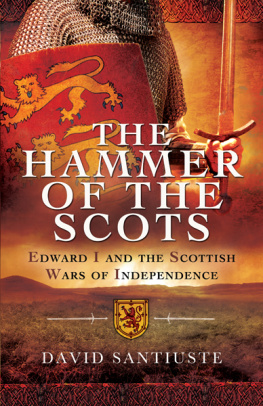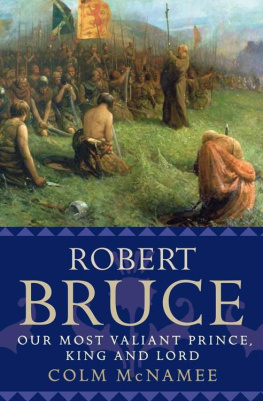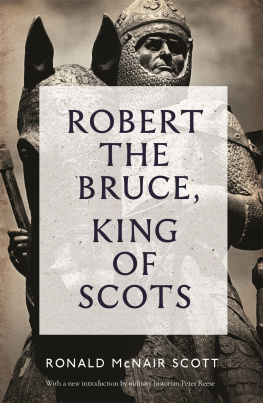THE WARS OF THE BRUCES
For Dorothy

This eBook edition published in 2012 by
Birlinn Limited
West Newington House
Newington Road
Edinburgh
EH9 1QS
www.birlinn.co.uk
First published in 1997 by Tuckewell Press
This edition published in 2006 by
John Donald, an imprint of Birlinn Ltd
Copyright Colm McNamee, 1997, 2006
The moral right of Colm McNamee to be identified as the author of this work has been asserted by him in accordance with the Copyright, Designs and Patents Act 1988
All rights reserved. No part of this publication may be reproduced, stored or transmitted in any form without the express written permission of the publisher.
ISBN: 978-0-85976-653-1
eBook ISBN: 978-0-85790-495-9
British Library Cataloguing-in-Publication Data
A catalogue record for this book is available from the British Library
Contents
Preface
T his is a study of war and society in the British Isles. It began life as an Oxford D.Phil on the effects of Scottish raids on northern England, but since its completion in 1989 the following changes have been incorporated: a synthesis of recent research on the war in Scotland; additional sections on other theatres of war, namely Ireland, and the war in the North and Irish seas; and some consideration of the wider implications of the Wars of the Bruces, for England and Ireland as well as Scotland, as a phase in the political development of the British Isles. The emphasis on the wider implications of the war is justified by the fact that the vast bulk of the archive material relating to the war emanates from the English royal government which was unable to operate in Scotland from 1311.
My approach is to examine the Wars of the Bruces as a whole, to consider relationships between the various theatres of war and to take into account economic, social and geographical constraints and motivation. The effects of the Wars outside Scotland have never been systematically examined; but an excellent start was made in the transcending of national histories in Dr. Sean Duffys 1991 article The Bruce Brothers and the Irish Sea World, 130629, in Cambridge Medieval Celtic Studies xxi (1991), 5586. Endeavouring, however, to maintain a strong narrative thread and to keep the text comprehensible to the non-specialist, I have found it necessary to devote separate chapters to various theatres of war. I have striven to maintain a balance between integration and clarity. There is one theatre of conflict which I have not covered, namely the diplomatic wrangles at the French and papal courts. Lacking familiarity with the sources and finding it adequately covered in existing works, I have left the further elucidation of this aspect to other writers. I would venture to say that as a study of war and society in the British Isles, the present work has not suffered markedly from the omission.
The Anglo-Scottish wars of 1306 to 1328 have tended to be written of principally in terms of biographies of the major characters. Robert I, Edward I and the English earls of Pembroke and Lancaster have all been the subject of great biographies, and a biography of Edward II is forthcoming. To these the present work is heavily indebted; and as the title suggests, I have found it undesirable to suppress the role of the personalities. This book is a drawing together of the work of many scholars: Duncan and Barrow, Phillips and Maddicott, Prestwich and Fryde, Lydon and Duffy, to name only the main authorities. My debt to them will be readily apparent to the reader.
Furthermore, the writing of this book has been greatly facilitated by the appearance in recent years of several major contributions to the history of the period; these include the supplementary volume to Bains Calendar of Documents Relating to Scotland; Duncans edition of the actae of Robert I, published as the fifth volume of the Regesta Regum Scottorum; Prestwichs biography of Edward I and Barrows revised edition of Robert Bruce and the Community of the Realm of Scotland; and finally, the new edition of Barbours Bruce.
I have tried to make the history as comprehensible to as many readers as possible by reducing technical terms to a bare minimum, referring to translations of the narrative sources where possible, and using the more familiar forms of place and personal names (hence MacDowell rather than MacDoual, Harclay rather than de Harcla, and Larne rather than Ulfreksfiord). I strayed from this general rule in the case of Gaelic Irish forms, where I have abided by the usage of the New History of Ireland.
Manuscript references are to documents held in the Public Record Office, London, unless some other record repository is specified.
Acknowledgements
P rofessor A.A.M. Duncan of the University of Glasgow was the prime mover behind this present work. He wrote to me in September 1995 encouraging me to publish my doctoral thesis. He has read draft chapters and has made many invaluable suggestions and comments. I think Professor Duncan had in mind a book very different to this when he first wrote to me, and I hope he finds no cause to regret his encouragement. Dr. David Ditchburn of the University of Aberdeen has been extremely helpful. He very kindly obtained material to which I would not otherwise have had access, and read and commented on a draft chapter. Dr. John Maddicott of Exeter College, Oxford, supervised the original thesis, and Mr. James Campbell advised and commented on the same. I am very grateful to both.
At the Queens University of Belfast, Professor Bruce Campbell made available to me information from Inquisitiones Post Mortem contained in his Pre-Black Death Database; Dr Kay Muir and her team at the Ulster Placenames Project advised on problems relating to Irish placenames and personal names; Dr. Judith Green and Dr. Marie Thrse Flanagan provided advice and encouragement. In a very real way Anthony Sheehan made it possible for me to write this book by providing access to wordprocessing facilities and by finding solutions to innumerable technical problems. Dr. Janette Lee provided similar assistance in the production of maps. Anthony and Estelle Sheehan very kindly assisted with translation of several awkward passages of Latin.
I acknowledge the assistance of the Department of Education for Northern Ireland who awarded a Major State Studentship (19821985); and the Institute of Irish Studies at Queens University Belfast, where I was Junior Research Fellow (19901991).
I am also very grateful to the following who helped in various ways: Professor David Harkness, Dr. Mary ODowd, Paula Gibson and John and Gerard McNamee. Above all I thank my wife, who has supported me during the writing of the present work and to whom this book is dedicated.
For any mistakes which this book may contain the responsibility is entirely my own.
List of Maps and Charts
Abbreviations
AA | Archaeologia Aeliana |
BAR | Bursars Account Rolls |
Barbour, The Bruce | Barbours Bruce, ed. M.P. McDiarmid and J.A.C. Stevenson (3 vols.) (Scottish Text Society, 4th series, 198085) |
Barrow, Robert Bruce | G.W.S. Barrow, Robert Bruce and the Community of the Realm of Scotland (Third Edition, London, 1988) |
Bower | Scotichronicon by Walter Bower, ed. D.E.R. Watt (198991) (Vol. 6) (Books XI and XII) |
Next page
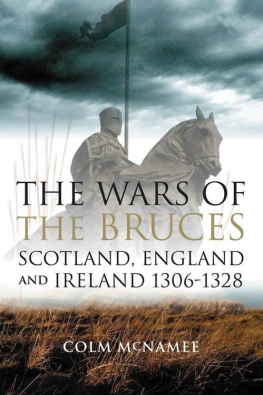
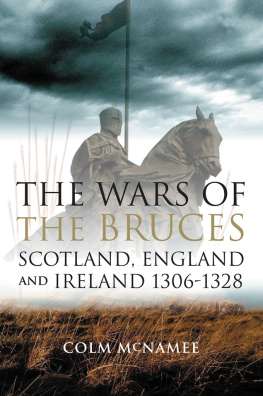
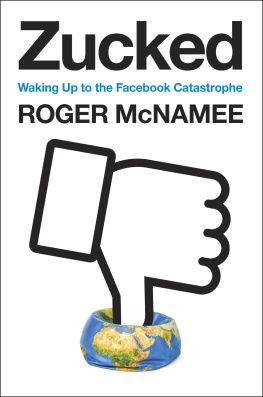

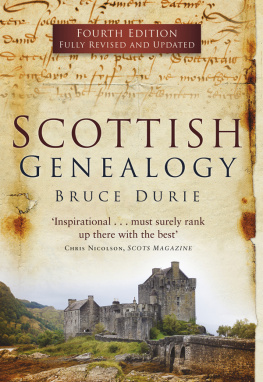
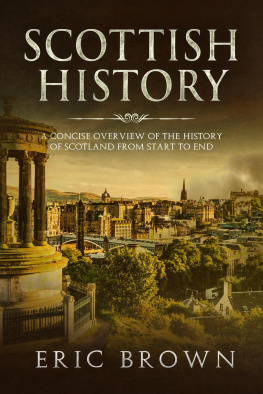
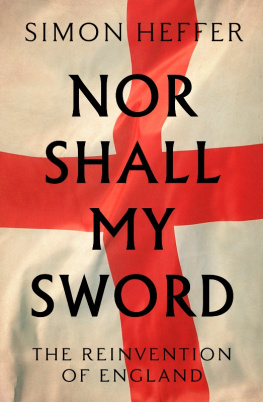
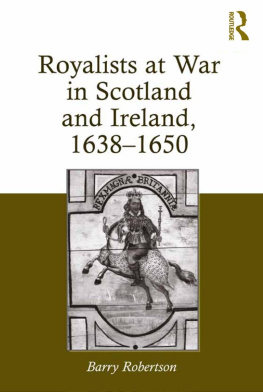
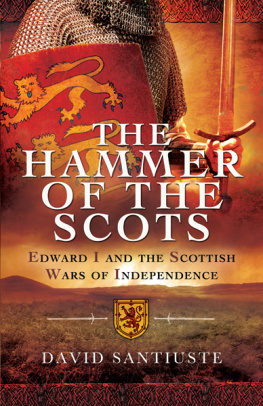
![Watson - Under the hammer : Edward I and Scotland, 1286-1306 [sic]](/uploads/posts/book/103524/thumbs/watson-under-the-hammer-edward-i-and-scotland.jpg)
